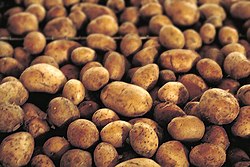馬鈴薯
Chinese
[edit]| bell tied to a horse; sleigh bell; jingle bell | potato; yam | ||
|---|---|---|---|
| trad. (馬鈴薯) | 馬鈴 | 薯 | |
| simp. (马铃薯) | 马铃 | 薯 | |
Etymology
[edit]Suzuki (2013) suggests that 馬鈴/马铃 (mǎlíng) may be a corruption of 馬來/马来 (Mǎlái, “Malay”), but the form 馬來薯/马来薯 has never been attested, and as Xiang (2018) points out, potato is a a temperate crop rarely cultivated in hot and humid tropical Asia.
The earliest known attestation in Chinese is found in the Kangxi edition of the Gazetteer of Songxi County (松溪縣志, 1700), but it is desribed as a tree climber with blackish tubers tasting bitterish and therefore should refer to air potato (Dioscorea bulbifera) instead of potato. The name is probably an allusion to the way the bulbils of air potato look like bells used in the tack for horses. The Japanese herbalist Ono Ranzan (小野蘭山) misapplied the name to potato in Tetsuen Shōtoku (耋筵小牘, 1808), and this altered denotation was first borrowed into Chinese by Huang Zunxian (黃遵憲) in the late 19th century (Xiang, 2018).
Pronunciation
[edit]- Mandarin
- Cantonese (Jyutping): maa5 ling4 syu4
- Hakka
- Northern Min (KCR): mǎ-lâing-cṳ̂
- Southern Min
- (Hokkien, POJ): má-lêng-chû / má-lêng-chîr / má-lêng-chî / bé-lêng-chû / bé-lêng-chîr / bé-lêng-chî
- (Teochew, Peng'im): bhê2 lêng5 ze5 / bhê2 lêng1 ze5
- Mandarin
- (Standard Chinese)+
- Hanyu Pinyin:
- Zhuyin: ㄇㄚˇ ㄌㄧㄥˊ ㄕㄨˇ
- Tongyong Pinyin: mǎlíngshǔ
- Wade–Giles: ma3-ling2-shu3
- Yale: mǎ-líng-shǔ
- Gwoyeu Romatzyh: maalingshuu
- Palladius: малиншу (malinšu)
- Sinological IPA (key): /mä²¹⁴⁻²¹ liŋ³⁵ ʂu²¹⁴⁻²¹⁽⁴⁾/
- (Standard Chinese)+
- Cantonese
- (Standard Cantonese, Guangzhou–Hong Kong)+
- Jyutping: maa5 ling4 syu4
- Yale: máh lìhng syùh
- Cantonese Pinyin: maa5 ling4 sy4
- Guangdong Romanization: ma5 ling4 xu4
- Sinological IPA (key): /maː¹³ lɪŋ²¹ syː²¹/
- (Standard Cantonese, Guangzhou–Hong Kong)+
- Hakka
- (Northern Sixian, incl. Miaoli)
- Pha̍k-fa-sṳ: mâ-làng-sù
- Hakka Romanization System: maˊ langˇ suˇ
- Hagfa Pinyim: ma1 lang2 su2
- Sinological IPA: /ma²⁴ laŋ¹¹ su¹¹/
- (Southern Sixian, incl. Neipu)
- Pha̍k-fa-sṳ: mâ-làng-sù / mâ-lìn-sù
- Hakka Romanization System: maˊ langˇ suˇ / maˊ linˇ suˇ
- Hagfa Pinyim: ma1 lang2 su2 / ma1 lin2 su2
- Sinological IPA: /ma²⁴ laŋ¹¹ su¹¹/, /ma²⁴ lin¹¹ su¹¹/
- (Hailu, incl. Zhudong)
- Hakka Romanization System: maˋ lang shu / maˋ lin shu
- Sinological IPA: /ma⁵³ laŋ⁵⁵ ʃu⁵⁵/, /ma⁵³ lin⁵⁵ ʃu⁵⁵/
- (Meixian)
- (Northern Sixian, incl. Miaoli)
- Northern Min
- (Jian'ou)
- Kienning Colloquial Romanized: mǎ-lâing-cṳ̂
- Sinological IPA (key): /ma²¹ laiŋ³³ t͡sy³³/
- (Jian'ou)
- Southern Min
- (Hokkien: Xiamen, Taipei, Tainan, Magong)
- Pe̍h-ōe-jī: má-lêng-chû
- Tâi-lô: má-lîng-tsû
- Phofsit Daibuun: maflengzuu
- IPA (Taipei): /mã⁵³⁻⁴⁴ liɪŋ²⁴⁻¹¹ t͡su²⁴/
- IPA (Tainan): /mã⁵³⁻⁵⁵ liɪŋ²⁴⁻³³ t͡su²⁴/
- IPA (Xiamen): /mã⁵³⁻⁴⁴ liɪŋ²⁴⁻²² t͡su²⁴/
- (Hokkien: Quanzhou, Lukang, Sanxia, Hsinchu)
- Pe̍h-ōe-jī: má-lêng-chîr
- Tâi-lô: má-lîng-tsîr
- IPA (Lukang): /mã⁵⁵⁻³⁵ liɪŋ²⁴⁻²² t͡sɨ²⁴/
- IPA (Quanzhou): /mã⁵⁵⁴⁻²⁴ liɪŋ²⁴⁻²² t͡sɯ²⁴/
- (Hokkien: Zhangzhou, Kaohsiung, Yilan)
- Pe̍h-ōe-jī: má-lêng-chî
- Tâi-lô: má-lîng-tsî
- Phofsit Daibuun: maflengcii
- IPA (Zhangzhou): /mã⁵³⁻⁴⁴ liɪŋ¹³⁻²² t͡si¹³/
- IPA (Kaohsiung): /mã⁴¹⁻⁴⁴ liɪŋ²³⁻³³ t͡si²³/
- IPA (Yilan): /mã⁵³⁻⁵⁵ liɪŋ²⁴⁻³³ t͡si²⁴/
- (Hokkien: variant in Taiwan)
- Pe̍h-ōe-jī: bé-lêng-chû
- Tâi-lô: bé-lîng-tsû
- Phofsit Daibuun: beflengzuu
- IPA (Taipei): /be⁵³⁻⁴⁴ liɪŋ²⁴⁻¹¹ t͡su²⁴/
- (Hokkien: Lukang)
- Pe̍h-ōe-jī: bé-lêng-chîr
- Tâi-lô: bé-lîng-tsîr
- IPA (Lukang): /be⁵⁵⁻³⁵ liɪŋ²⁴⁻²² t͡sɨ²⁴/
- (Hokkien: Taichung)
- Pe̍h-ōe-jī: bé-lêng-chî
- Tâi-lô: bé-lîng-tsî
- Phofsit Daibuun: beflengcii
- (Teochew)
- Peng'im: bhê2 lêng5 ze5 / bhê2 lêng1 ze5
- Pe̍h-ōe-jī-like: bé lêng tsṳ̂ / bé leng tsṳ̂
- Sinological IPA (key): /be⁵²⁻³⁵ leŋ⁵⁵⁻¹¹ t͡sɯ⁵⁵/, /be⁵²⁻³⁵ leŋ³³⁻²³ t͡sɯ⁵⁵/
- (Hokkien: Xiamen, Taipei, Tainan, Magong)
Noun
[edit]馬鈴薯
Synonyms
[edit]Derived terms
[edit]Descendants
[edit]- → Lingao: ma⁴ liŋ¹ su⁴
- → Zhuang: majlingzsuz
Japanese
[edit]| Kanji in this term | ||
|---|---|---|
| 馬 | 鈴 | 薯 |
| ば Grade: 2 |
れい Grade: S |
しょ Hyōgai |
| on'yomi | ||

Etymology
[edit]It has been suggested that 馬鈴 (barei) may be an ateji for Malay, but the earliest attestation in Japanese sources is found in Tetsuen Shōtoku (耋筵小牘, 1808) where the Japanese herbalist Ono Ranzan (小野蘭山) clearly indicates that the term is taken from a Chinese source, the Gazetteer of Songxi County (松溪縣志, 1700). However, the Chinese term should refer to air potato (Dioscorea bulbifera) instead of potato, as it is desribed as a tree climber with blackish tubers tasting bitterish. The name is probably an allusion to the way the bulbils of air potato look like bells used in the tack for horses. Ono Ranzan misapplied the name to potato, and this altered denotation, in spite of strong criticisms from the botanist Makino Tomitaro (牧野富太郎), prevailed over the original meaning (Xiang, 2018).
Pronunciation
[edit]Noun
[edit]Synonyms
[edit]Derived terms
[edit]References
[edit]- Chinese lemmas
- Mandarin lemmas
- Cantonese lemmas
- Hakka lemmas
- Northern Min lemmas
- Hokkien lemmas
- Teochew lemmas
- Chinese nouns
- Mandarin nouns
- Cantonese nouns
- Hakka nouns
- Northern Min nouns
- Hokkien nouns
- Teochew nouns
- Chinese terms with IPA pronunciation
- Chinese terms spelled with 馬
- Chinese terms spelled with 鈴
- Chinese terms spelled with 薯
- Chinese terms with archaic senses
- Advanced Mandarin
- zh:Potatoes
- Japanese terms spelled with 馬 read as ば
- Japanese terms spelled with 鈴 read as れい
- Japanese terms spelled with 薯 read as しょ
- Japanese terms read with on'yomi
- Japanese terms with IPA pronunciation
- Japanese lemmas
- Japanese nouns
- Japanese terms spelled with second grade kanji
- Japanese terms spelled with secondary school kanji
- Japanese terms spelled with hyōgai kanji
- Japanese terms with 3 kanji
- ja:Potatoes
